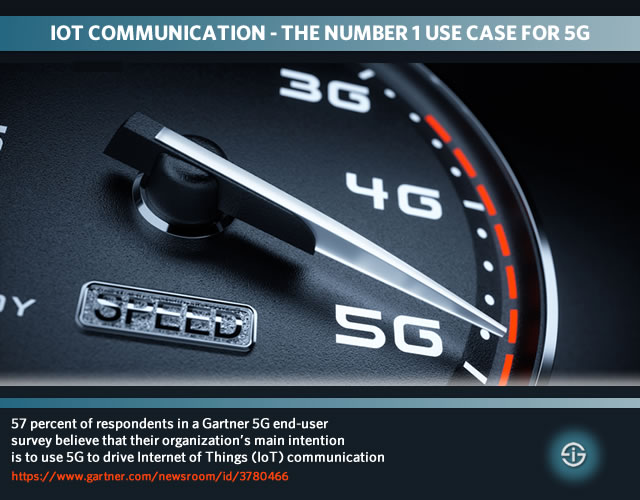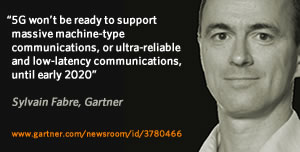5G is far from ready to be deployed for IoT and still has several years to go before it can even fulfil its promises for massive IoT.
Still, that doesn’t mean that organizations are not looking at 5G and IoT communication yet. And how else could it be? However, the fact that IoT communication surfaced as the main use case for 5G in a Gartner survey, despite a wrong perception about when 5G will be widely available, is probably the single most unexpected and surprising result from that survey, announced by the company on August 9, 2017.
The Gartner 5G survey wasn’t meant to just look at use cases, let alone at the plans for 5G by organizations in the wireless IoT landscape. The announcement about the Gartner 5G survey instead focuses on the willingness to pay more for 5G mobile capabilities by end-user organizations. So, let’s look at that first before tackling the IoT communication findings.

The willingness to pay more for 5G – takeaways
According to the press release from Gartner, the research firm 75 percent of end-user organizations would be willing to pay more for 5G and only 24 percent would be unwilling to do so.
Research director Sylvain Fabre states that those in the telecom industry are more likely to be prepared to pay more for 5G as compared with end-user organizations in sectors such as manufacturing, services and government.
The results lead Gartner to advice to offer better prices in those industries where end users seem less convinced about the business benefits of 5G. Of course, price is not the only thing. Focusing on the demonstration of the business benefits in those industries is another approach.
In manufacturing, for instance, that shouldn’t be too hard in the coming years amid the ongoing digital transformation of manufacturing and the rising attention for Industry 4.0 by governments across the globe and by myriad industrial organizations. In some regions, such as the EU, 5G is even part of several plans to move towards the next stages in the digital market. 5G and IoT is definitely on government agendas for applications in the scope of manufacturing, smart cities and more.
Gartner advices CSPs (communications service providers) to create the value propositions that would make customers start their migration projects regarding 5G sooner. It’s probably also a good idea for 5G stakeholders to focus on the overall benefits and value propositions of 5G in those markets and end-user organizations where willingness to pay more and perceived benefits are lower but potential across key use cases is higher.
The perception of 5G as an enabler of digital business versus 5G as a network evolution
One of the other challenges is that many respondents see 5G as just a network evolution instead as an enabler of digital business.
So, it seems that the efforts to position 5G as an enabler of digital transformation with a redefinition of what mobility means, based on a new architecture and with not just higher data rates but also additional network capacities and new services in an edgeless computing vision, so far haven’t really paid off.
Maybe not that surprisingly mainly respondents from the telecom industry are less persuaded about the fact that 5G will enhance revenues. Sylvain Fabre: “They tend to see 5G migration as a matter of gradual and inevitable infrastructural change, rather than as an opportunity to generate new revenue”.
In total only 8 percent of respondents expect 5G to lead to cost savings or higher revenues, despite the fact that the majority expects their organizations being willing to pay more for 5G.

Only 37 percent of respondents mention 5G as an enabler of digital business, compared with 59 percent who see it as a mobile network evolution. Of course, all in all, it is still relatively early days and by the time that 5G is really here, attitudes will have changed, given the omnipresence of 5G at virtually every major tradeshow where technology is important, from smart city conferences to IoT events and beyond.
That brings us to the IoT aspect and that of connected vehicles, smart cities, industrial internet and all those use cases in IoT and industries and applications of massive IoT.
The surprising place of IoT communications as the main 5G use case
As mentioned, the number one use case respondents see for 5G is IoT communications with 57 percent of respondents believing that the key intention of their organizations is to leverage 5G to drive IoT communication (and thus the deployment of IoT across the mentioned areas and far more).
By way of comparison: almost half of respondents intend to use 5G to access video and fixed wireless capabilities, making the importance of IoT communications in 5G even clearer.
The finding that IoT communication is the main use case for 5G is surprising and unexpected for several reasons. Sylvain Fabre cites the main ones.
- First, Gartner expects that the number of deployed connected things in IoT that need cellular connectivity will not exceed the capacity of the existing cellular IoT technologies before 2023 in most regions.
- Secondly, Sylvain Fabre reminds, even when 5G is fully implemented it will only be a good fit for a small subset of IoT use case requiring the combination of very high date rates (in the Gbps range) and low latency.
- Thirdly, it will take at least until early 2020 before 5G is even able to support massive machine-type communications, or ultra-reliable and low-latency communications.
It’s not just about cellular and 5G of course: there are ample proven wireless IoT connectivity protocols and networks that are suited for many IoT use cases without the costs and complexity of 5G.
The confusions about the wide availability of 5G
To understand the findings it needs to be said that a whopping 84 percent of respondents believes that 5G will be widely available by 2020.
The plans of communications service providers, however, lead Gartner to believe that wide 5G availability won’t happen before 2020 and that by 2020 only 3 percent of the global network-owning communications service providers will have commercially rolled out 5G networks.
Sylvain Fabre: “Although standards-compliant commercial network equipment could be available by 2019, commercial rollouts of 5G networks and services by CSPs before 2019 are likely to use prestandard equipment”.
More in the press release and in Gartner’s report “User Confusion About 5G Demands CSP Action.”
Top image: Shutterstock – Copyright: dencg – All other images are the property of their respective mentioned owners.

